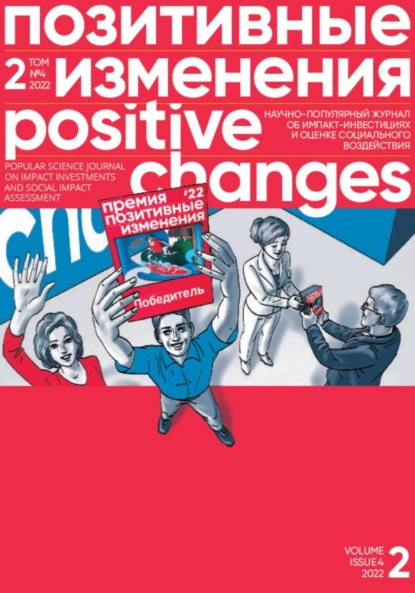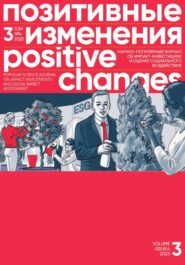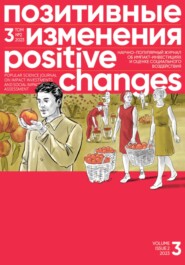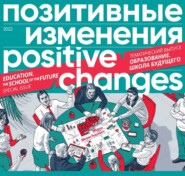По всем вопросам обращайтесь на: info@litportal.ru
(©) 2003-2024.
✖
Позитивные изменения. Том 2, №4 (2022). Positive changes. Volume 2, Issue 4 (2022)
Настройки чтения
Размер шрифта
Высота строк
Поля
FINANCIAL SUSTAINABILITY MODEL
The company generates revenue from sales of the basic electric wheelchair model, “OBSERVER standard.”
Northern Heritage Foundation
Porato Project – Preservation of Tangible and Intangible Cultural Heritage.
https://vk.com/id757234859
The Northern Heritage Foundation revives and refreshes traditional crafts in rural areas, develops the tourist potential of the territories, develops tourist routes and supports local producers.
PROBLEM ADDRESSED
The Arkhangelsk region had once been famous for weaving – almost every home had a loom. Irina Mezhinskaya asked the residents of Oshevensk, a village with population of 500, why they were not weaving anymore. The answer was: “We have no rags.” The residents of Kargopol, the town nearest to Oshevensk, gave the same answer.
That's how the idea of a project to revive weaving emerged. Irina Mezhinskaya arranged for shipments of rags from Moscow to the village, so that artisans could make rugs and mats and earn money selling their products.
“More often than not, people donate their old clothes to thrift stores like The Second Breath or The Joy Shop. Any clothes in good condition are given to the needy. But there are still items that cannot be worn or reused. For example, bed sheets. You could wash it, remove any worn or damaged fragments, and get a very good material for use in weaving,” says Irina Mezhinskaya.
Another partner in the project is a garment factory in Moscow, which agreed to give away scraps of fabric.
“That's how the story began. Today we collect rags in Moscow, prepare them, wash and sort, then send to the village, where the craftswomen weave mats and return them to us in Moscow for sale, or sell them locally to tourists. We have already sold about 700 meters of mats. There are craftswomen not only in our village, but also in neighboring villages, who ask to be included in the project,” Irina Mezhinskaya says.
METHODS USED TO ADDRESS THE PROBLEM
Creation of new jobs, support and development of traditional crafts, conservation of natural resources, recycling. Assistance in setting up a workspace at home or in a village workshop area.
Every craftswoman who decides to do weaving has a loom at home. There are also workshops where weaving is taught.
Another direction of the project is the development of tourism potential of the Russian North. Kargopol is a fairly well-known place among people who plan a trip to the North. The city is a year older than Moscow, it has the same rich history as Suzdal and Vladimir. The Moscow-Arkhangelsk railroad passed through Nyandoma, population 30,000. Another 80 km by bus or car – and you get to the town of Kargopol, and another 40 km on is Oshevenskoe municipality.
“The place has the Alexander Oshevensky monastery, a wooden church, and chapels. All this will be especially interesting for tourists interested in wooden architecture. The place is rich with all kinds of legends and tales. There is a river that disappears into the ground at one end of the village and resurfaces at the other end. Legends have it that this happened because a saint was once prevented from drinking water there. Also nearby is Kenozero National Park. And Oshevensk itself has a guest house and a village hotel,” Irina Mezhinskaya says.
In addition to weaving, the Porato project also supports craftswomen making embroidery: embroidered sundresses, pillowcases, towels.
WHAT WAS DONE LAST YEAR
In 2021, about 200 meters of homemade mats were produced and sold, with the proceeds amounting to about 200,000 rubles. One craftswoman embroidered a sundress to order. She was able to renovate her kitchen with the money earned.
Because of the COVID-19 pandemic and respective restrictions, the Northern Heritage Foundation had low expectations of tourism in 2021. During the year, about 70 tourists visited the area, leaving a total of about 1 million rubles in Kargopol, Nyandoma and Oshevensk.
Together with the Kargopol Museum and The Three Squares publishing house, a book titled “Kargopol” was published, which includes a large section on the town's wooden architecture and plenty of information about Oshevensk.
SOCIAL AND ECONOMIC IMPACT
The use of recycled materials and production of new artisanal products has increased. Artisans participate in craft competitions and demonstrate their products at various exhibitions. Residents of neighboring villages become interested in their experience and join the project. Weaving generates interest towards other crafts – garment-making, embroidery, patchwork, knitting. Such activities help unite the village residents. The local folk ensemble “Bolshukhas from Oshevensk” got a new breath of life.
“We gave the local seamstresses the fabric to make 11 sundresses. They checked with the museum to learn how to make traditional Kargopol sundresses properly; the museum staff showed them everything and taught them. They wore these sundresses all year long, going everywhere, giving concerts. This also highlighted the project's activities,” says Irina Mezhinskaya.
SOCIAL EFFECTS ACHIEVED IN 2021
The main achievement of the work at this stage, according to the project author, is winning the trust of rural artisans and inspiring them to continue their development. New craftswomen are joining the project, interest in weaving looms is growing, and some of the residents are thinking about growing their own linen.
“The artisans come together, holding work meetings as they discuss how to weave. They don't treat weaving as a line production; they care about their activity creating value. To them, their mats aren't just striped, colored, red or green; they talk about them differently: “Here we have a sunset, here a field, this is a swamp, and this here is a berry.” That is, they clearly have a very palpable aesthetic perception of their work. Each doormat is special, original. Because it is made of rags, the pattern never repeats,” Irina Mezhinskaya explains.
Village residents are increasingly asking the author of the project: “What can we do, what can we sell, what can we make to earn some money?” It's a story about believing in yourself, Mezhinskaya believes.
“I had another woman approach me; she makes teterkas – local traditional decorated oven-baked rye bread. She said: “I can make teterkas, but I have to come up with the packaging.” Our designer made the logo, and we called the product “Bolshukha's Treat.” Bolshukha is the eldest woman in the family. We also made postcards for her with a description and recipe. Now, when tourists come to this woman's house for lunch, they can buy a box of teterkas to take home. I think this is also a good social effect,” Irina Mezhinskaya says.
FINANCIAL SUSTAINABILITY MODEL
Proceeds from the sales of mats in Moscow at the Northern Heritage Foundation's events and online, as well as at the Foundation's websites.
notes
Примечания
1
Ким, А. И., Копыток, В. К., Филиппова, Ю. А., & Цыганков, М. В. (2020). Применение теории изменений для стратегического аудита и стратегического планирования в России. Счетная палата Российской Федерации, Центр перспективных управленческих решений. Режим доступа: https://cpur.ru/teoriya_izmenenij. (дата доступа: 09.12.2022).
2
Weiss, C. H. (1995). Nothing as practical as good theory: Exploring theory-based evaluation for comprehensive community initiatives for children and families. New approaches to evaluating community initiatives: Concepts, methods, and contexts, 1, 65–92.
3
Счетная палата Российской Федерации. (2021). Сборник лучших практик и инициатив применения доказательного подхода к принятию управленческих решений. По итогам 1-го Конкурса Счетной палаты Российской Федерации. Москва. Режим доступа: https://ach.gov.ru/upload/iblock/769/a8sk3xrqzdtomz4chspi3r8xkav4wp0f.pdf. (дата доступа: 09.12.2022).
4
Байрамкулов, А. & Хакимов, А. (2022). Ambrosia – Open Source-библиотека для работы с A/B-тестами. Режим доступа: https://habr.com/ru/company/ru_mts/blog/700992/. (дата доступа: 09.12.2022).
5
ЦСИО «СОЛь». (2014). Стандарт социальной отчётности. Как составлять отчётность на основе результатов своей деятельности. Режим доступа: https://impact.ngo.ru/library/view/31. (дата доступа: 09.12.2022).
6
Стандарт доказательности социальных практик в сфере детства. (2018). Москва. Режим доступа: https://timchenkofoundation.org/wp-content/uploads/2020/02/standart_dokazatelnosti_socialnyh_prakti_v_sfere_detstva.pdf. (дата доступа: 09.12.2022).
7
Рудина-Ладыжец, Е. (2022). Сообщества как драйвер развития территории. Опыт проекта «Солидарные сообщества». Позитивные изменения. 48–59. https://doi.org/10.55140/2782–5817–2022–2-S2–48–59.
8
Ядро. Проект БФ «Нужна помощь». (2022). Режим доступа: https://core.nuzhnapomosh.ru/.(дата доступа: 09.12.2022).














